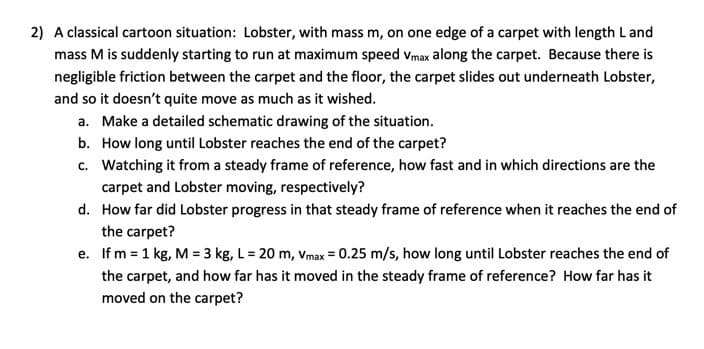2) A classical cartoon situation: Lobster, with mass m, on one edge of a carpet with length Land mass M is suddenly starting to run at maximum speed Vmax along the carpet. Because there is negligible friction between the carpet and the floor, the carpet slides out underneath Lobster, and so it doesn't quite move as much as it wished. a. Make a detailed schematic drawing of the situation. b. How long until Lobster reaches the end of the carpet? c. Watching it from a steady frame of reference, how fast and in which directions are the carpet and Lobster moving, respectively? d. How far did Lobster progress in that steady frame of reference when it reaches the end of the carpet? e. Ifm = 1 kg, M = 3 kg, L = 20 m, Vmax = 0.25 m/s, how long until Lobster reaches the end of the carpet, and how far has it moved in the steady frame of reference? How far has it moved on the carpet?
2) A classical cartoon situation: Lobster, with mass m, on one edge of a carpet with length Land mass M is suddenly starting to run at maximum speed Vmax along the carpet. Because there is negligible friction between the carpet and the floor, the carpet slides out underneath Lobster, and so it doesn't quite move as much as it wished. a. Make a detailed schematic drawing of the situation. b. How long until Lobster reaches the end of the carpet? c. Watching it from a steady frame of reference, how fast and in which directions are the carpet and Lobster moving, respectively? d. How far did Lobster progress in that steady frame of reference when it reaches the end of the carpet? e. Ifm = 1 kg, M = 3 kg, L = 20 m, Vmax = 0.25 m/s, how long until Lobster reaches the end of the carpet, and how far has it moved in the steady frame of reference? How far has it moved on the carpet?
Related questions
Question

Transcribed Image Text:2) A classical cartoon situation: Lobster, with mass m, on one edge of a carpet with length L and
mass M is suddenly starting to run at maximum speed Vmax along the carpet. Because there is
negligible friction between the carpet and the floor, the carpet slides out underneath Lobster,
and so it doesn't quite move as much as it wished.
a. Make a detailed schematic drawing of the situation.
b. How long until Lobster reaches the end of the carpet?
c. Watching it from a steady frame of reference, how fast and in which directions are the
carpet and Lobster moving, respectively?
d.
How far did Lobster progress in that steady frame of reference when it reaches the end of
the carpet?
e. If m = 1 kg, M = 3 kg, L = 20 m, Vmax = 0.25 m/s, how long until Lobster reaches the end of
the carpet, and how far has it moved in the steady frame of reference? How far has it
moved on the carpet?
Expert Solution
This question has been solved!
Explore an expertly crafted, step-by-step solution for a thorough understanding of key concepts.
Step by step
Solved in 2 steps with 1 images
